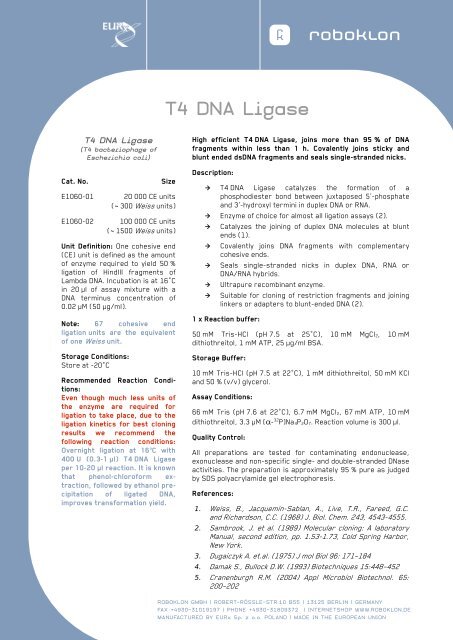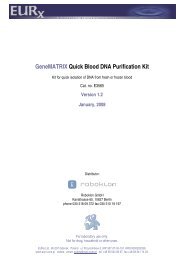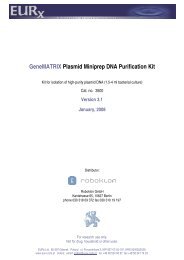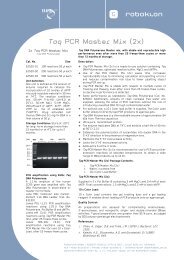T4 DNA Ligase - roboklon
T4 DNA Ligase - roboklon
T4 DNA Ligase - roboklon
Create successful ePaper yourself
Turn your PDF publications into a flip-book with our unique Google optimized e-Paper software.
<strong>T4</strong> <strong>DNA</strong> <strong>Ligase</strong><br />
(<strong>T4</strong> bacteriophage of<br />
Escherichia coli)<br />
Cat. No. Size<br />
E1060-01 20 000 CE units<br />
(~ 300 Weiss units)<br />
E1060-02 100 000 CE units<br />
(~ 1500 Weiss units)<br />
Unit Definition: One cohesive end<br />
(CE) unit is defined as the amount<br />
of enzyme required to yield 50 %<br />
ligation of HindIII fragments of<br />
Lambda <strong>DNA</strong>. Incubation is at 16°C<br />
in 20 µl of assay mixture with a<br />
<strong>DNA</strong> terminus concentration of<br />
0.02 µM (50 µg/ml).<br />
Note: 67 cohesive end<br />
ligation units are the equivalent<br />
of one Weiss unit.<br />
Storage Conditions:<br />
Store at -20°C<br />
Recommended Reaction Conditions:<br />
Even though much less units of<br />
the enzyme are required for<br />
ligation to take place, due to the<br />
ligation kinetics for best cloning<br />
results we recommend the<br />
following reaction conditions:<br />
Overnight ligation at 16 o C with<br />
400 U (0.3-1 µl) <strong>T4</strong> <strong>DNA</strong> <strong>Ligase</strong><br />
per 10-20 µl reaction. It is known<br />
that phenol-chloroform extraction,<br />
followed by ethanol precipitation<br />
of ligated <strong>DNA</strong>,<br />
improves transformation yield.<br />
<strong>T4</strong> <strong>DNA</strong> <strong>Ligase</strong><br />
High efficient <strong>T4</strong> <strong>DNA</strong> <strong>Ligase</strong>, joins more than 95 % of <strong>DNA</strong><br />
fragments within less than 1 h. Covalently joins sticky and<br />
blunt ended ds<strong>DNA</strong> fragments and seals single-stranded nicks.<br />
Description:<br />
> <strong>T4</strong> <strong>DNA</strong> <strong>Ligase</strong> catalyzes the formation of a<br />
phosphodiester bond between juxtaposed 5'-phosphate<br />
and 3'-hydroxyl termini in duplex <strong>DNA</strong> or RNA.<br />
> Enzyme of choice for almost all ligation assays (2).<br />
> Catalyzes the joining of duplex <strong>DNA</strong> molecules at blunt<br />
ends (1).<br />
> Covalently joins <strong>DNA</strong> fragments with complementary<br />
cohesive ends.<br />
> Seals single-stranded nicks in duplex <strong>DNA</strong>, RNA or<br />
<strong>DNA</strong>/RNA hybrids.<br />
> Ultrapure recombinant enzyme.<br />
> Suitable for cloning of restriction fragments and joining<br />
linkers or adapters to blunt-ended <strong>DNA</strong> (2).<br />
1 x Reaction buffer:<br />
50 mM Tris-HCl (pH 7.5 at 25°C), 10 mM MgCl2, 10 mM<br />
dithiothreitol, 1 mM ATP, 25 µg/ml BSA.<br />
Storage Buffer:<br />
10 mM Tris-HCl (pH 7.5 at 22°C), 1 mM dithiothreitol, 50 mM KCl<br />
and 50 % (v/v) glycerol.<br />
Assay Conditions:<br />
66 mM Tris (pH 7.6 at 22°C), 6.7 mM MgCl2, 67 mM ATP, 10 mM<br />
dithiothreitol, 3.3 µM [α- 32 P]Na4P2O7. Reaction volume is 300 µl.<br />
Quality Control:<br />
All preparations are tested for contaminating endonuclease,<br />
exonuclease and non-specific single- and double-stranded DNase<br />
activities. The preparation is approximately 95 % pure as judged<br />
by SDS polyacrylamide gel electrophoresis.<br />
References:<br />
1. Weiss, B., Jacquemin-Sablan, A., Live, T.R., Fareed, G.C.<br />
and Richardson, C.C. (1968) J. Biol. Chem. 243, 4543-4555.<br />
2. Sambrook, J. et al. (1989) Molecular cloning: A laboratory<br />
Manual, second edition, pp. 1.53-1.73, Cold Spring Harbor,<br />
New York.<br />
3. Dugaiczyk A. et.al. (1975) J mol Biol 96: 171–184<br />
4. Damak S., Bullock D.W. (1993) Biotechniques 15:448–452<br />
5. Cranenburgh R.M. (2004) Appl Microbiol Biotechnol. 65:<br />
200–202<br />
ROBOKLON GMBH | ROBERT-RÖSSLE-STR.10 B55 | 13125 BERLIN | GERMANY<br />
FAX +4930-31019197 | PHONE +4930-31809372 | INTERNETSHOP WWW.ROBOKLON.DE<br />
MANUFACTURED BY EURx Sp. z o.o. POLAND | MADE IN THE EUROPEAN UNION
LIGATION PROTOCOL<br />
Preparation of Ligation Reactions: Notes:<br />
Cohesive and Blunt Termini Ligation Protocol (2)<br />
> Digest plasmid and insert <strong>DNA</strong> with appropriate restriction<br />
enzymes.<br />
> Purify <strong>DNA</strong> by Phenol/Chloroform extraction or by spin column<br />
purification (e.g. EURx PCR/<strong>DNA</strong> Clean Up Kit, Cat. No. E3520).<br />
> Transfer 20-100 ng vector <strong>DNA</strong> and 1-3 x molar amounts of insert<br />
<strong>DNA</strong> (see formula below) to a plastic reaction tube. Total volume:<br />
8 to 8.8 µl (dependent on amount of <strong>T4</strong> <strong>DNA</strong> <strong>Ligase</strong>).<br />
> Heat to 45°C for 5 min to melt any reannealed cohesive termini.<br />
> Chill briefly on ice.<br />
> Add to 10 µl total: 10x <strong>T4</strong> <strong>DNA</strong> <strong>Ligase</strong> buffer 1 µl<br />
<strong>T4</strong> <strong>DNA</strong> <strong>Ligase</strong> 50 to 400 U<br />
> Incubate for 1 – 4 h (min. 10 min) at 16°C or 25°C (RT) (for<br />
cohesive ends) or for 1 - 16 h at 16°C (for blunt ends).<br />
> Use 1-2 µl of each ligation reaction for transformation.<br />
Note: <strong>T4</strong> <strong>DNA</strong> <strong>Ligase</strong> buffer contains ATP<br />
Note: Ligation of blunt-ended <strong>DNA</strong> is less efficient as compared to sticky<br />
ends ligation. For blunt end ligation, these additional prerequisites have to<br />
be met (2):<br />
- Low ATP concentrations (200 mM) strongly inhibit <strong>T4</strong> <strong>DNA</strong> <strong>Ligase</strong>.<br />
Two-step ligation protocol for Blunt-End Termini (4)<br />
This procedure is only recommended for blunt-end ligation if extremely<br />
high efficiency is required, e.g. for cloning libraries. It takes into account<br />
that the first step in ligation, intermolecular ligation events (vector to<br />
insert ends) preferentially occurs at high <strong>DNA</strong> concentrations, whether<br />
low <strong>DNA</strong> concentrations favor the second ligation step, joining of both <strong>DNA</strong><br />
strand ends for circularization.<br />
> Digest vector and insert <strong>DNA</strong> with appropriate restriction enzymes.<br />
> Ensure high vector and insert <strong>DNA</strong> concentrations (>50 ng µl -1 ).<br />
> Mix 0.1 µg vector <strong>DNA</strong> and an equimolar amount of insert <strong>DNA</strong>. Total<br />
volume 10 µl.<br />
Note: Under these conditions, vector to insert ligation is favored.<br />
> Incubate for 1 h at room temperature.<br />
> Dilute reaction 20 times with 1x <strong>T4</strong> <strong>Ligase</strong> buffer and <strong>T4</strong> <strong>DNA</strong> <strong>Ligase</strong>.<br />
Note: Under these conditions, self-ligation is favored and ligated<br />
molecules are circularized.<br />
> Incubate overnight at room temperature.<br />
Electroporation<br />
Use 1-2 µl (max. 5 µl) for transformation of 50 µl electro- or chemical<br />
competent cells. Transformation efficiency is enhanced by prolonged<br />
ligation time (1 h or longer), by heat inactivation (10 min, 65°C; not<br />
applicable with PEG) or by <strong>DNA</strong> ethanol precipitation.<br />
1. Prerequisites for efficient ligation:<br />
> Clean, well-purified <strong>DNA</strong> solutions of linearized vector<br />
and of insert <strong>DNA</strong>.<br />
> High <strong>DNA</strong> concentrations of linearized vector and insert<br />
<strong>DNA</strong> solutions (recommended 5 - 50 ng/µl) favor<br />
intermolecular over intramolecular (self-) ligation.<br />
Extremely high <strong>DNA</strong> concentrations lead to undesired<br />
formation of very long linear <strong>DNA</strong> fragments.<br />
> Vector and insert <strong>DNA</strong> in molar ratios between 1:1<br />
and 1:3 (recommended: 1:2). At vector / insert ratios<br />
of 1:1, intermolecular ligation is favored. For ratios<br />
> 1:3, self-ligation (multimer-formation) is preferred.<br />
2. Reaction speed: Velocity of the ligation reaction depends<br />
solely on the concentration of free, compatible <strong>DNA</strong> ends,<br />
regardless whether they are located on the same <strong>DNA</strong><br />
strand (intramolecular ligation) or on different <strong>DNA</strong><br />
strands (intermolecular ligation). Two factors favoring<br />
intermolecular ligation over self-ligation are high <strong>DNA</strong> concentrations<br />
and long <strong>DNA</strong> fragments. Contrary, low <strong>DNA</strong><br />
concentrations and small <strong>DNA</strong> fragments lead to a<br />
preference for self-ligation. Under the latter conditions it<br />
is more likely that two ends from one single molecule,<br />
rather than from different <strong>DNA</strong> strands, will get into close<br />
spatial contact. For detailed discussions see refs (2. 3. 4).<br />
3. Dephosphorylated <strong>DNA</strong>: An optional strategy to prevent<br />
self-ligation, is to remove 5'-phosphates from plasmid <strong>DNA</strong><br />
(but not from insert <strong>DNA</strong>) prior to ligation. Bacterial and<br />
Calf Intestine Phosphatase (Cat. No. E1026 and E1025)<br />
catalyze the removal of 5'-phosphate groups from <strong>DNA</strong><br />
and RNA (2). Dephosphorylation of plasmid <strong>DNA</strong> fragments<br />
efficiently prevents self-ligation, at the expense, that only<br />
two new phosphodiester bonds are formed during ligation<br />
(not four, as for phosphorylated <strong>DNA</strong> strands). Ligated<br />
molecules thus carry two nicks, which are repaired by the<br />
bacterial host following transformation.<br />
4. Condensing Agents: Substances generating macromolecular<br />
crowding effects (e.g. Polyethylene Glycol or<br />
Hexamminecobalt Chloride) can be used for increasing<br />
from low to adequate <strong>DNA</strong> concentrations for blunt end<br />
cloning (2). Useful Polyethylene Glycol (PEG8000) final<br />
concentrations range between 5 % and 15 %. Excess<br />
condensing agent concentrations lead to preferred formation<br />
of large linear <strong>DNA</strong>, which may inhibit transformation.<br />
5. Optional Control Reactions:<br />
> Cut vector, no insert – for estimating self-ligation<br />
background (blunt end: plus checking for ligatability).<br />
> Cut vector, no ligase - for estimating undigested<br />
vector background.<br />
> Uncut vector – for estimating efficiency of<br />
transformation.<br />
Calculation of Required Vector and Insert <strong>DNA</strong> Solution Volumes (5)<br />
Since ligation efficiency benefits from high initial <strong>DNA</strong> concentrations, the reaction is set up ideally without any diluting H2O. For a quick<br />
calculation of the optimally required vector and insert <strong>DNA</strong> solution volumes, a formula was devised by Cranenburgh (2004).<br />
(1)<br />
V v =<br />
T<br />
� �V c⋅ Il⋅ R�<br />
� 1<br />
�I c⋅V l� �<br />
(2) I v = T − V v<br />
Example:<br />
Short Description Example value Short Description Example value<br />
Il<br />
Ic<br />
Insert length<br />
Insert concentration<br />
1.8 kb<br />
20 ng µl<br />
Vl Vector length 3.2 kb<br />
-1 Vc Vector concentration 50 ng µl-1 R Insert / vector ratio 2 T Total <strong>DNA</strong> volume 8 µl<br />
Iv Insert volume To determine Vv Vector volume To determine<br />
(1)<br />
8 µl<br />
V v =<br />
��50 ng µl −1 ⋅1.8 kb⋅ 2�<br />
�20 ng µl −1 � 1<br />
⋅3.2 kb� �<br />
8 µl<br />
=<br />
� 180<br />
= 2,10 µl<br />
64 � � 1<br />
(2) I v = 8 µl−2,10 µl = 5,9 µl<br />
ROBOKLON GMBH | ROBERT-RÖSSLE-STR.10 B55 | 13125 BERLIN | GERMANY<br />
FAX +4930-31019197 | PHONE +4930-31809372 | INTERNETSHOP WWW.ROBOKLON.DE<br />
MANUFACTURED BY EURx Sp. z o.o. POLAND | MADE IN THE EUROPEAN UNION





